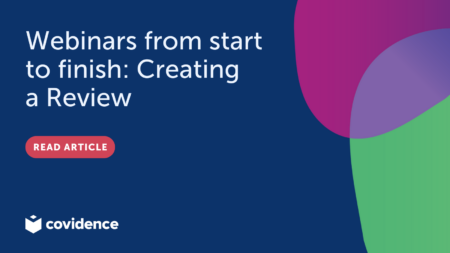Top 5 Tips for High-Quality Data Extraction
We hear from our users that data extraction can be a challenging part of the systematic review process. We’ve interviewed our expert systematic reviewers at Covidence and within our user community and distilled their insights into 5 top tips below.
First, let's define it...
Data extraction is the process of identifying and pulling data from study reports to allow analysis of similar data from different sources. It is the crucial part of any systematic or literature review process, intended to allow you to compile a big enough dataset to (hopefully!) produce significant evidence.
1. Have a plan

This can be anything from a basic outline to a published, peer-reviewed protocol; however you present it, it’s important to plan out your process before you begin and clearly define and document your inclusion and exclusion criteria that are likely to capture the data that will help answer your research question, and how to set up your data extraction form to capture this information effectively.
2. Execute a pilot

Set up a process to pilot your plan and communicate with your co-reviewers. Pilot each stage of the review process – start with screening, to check that all reviewers understand and agree on
the criteria. Another round is useful when starting data extraction, to ensure that the team is extracting the data necessary for an effective analysis (and also that all reviewers are extracting data consistently). Piloting quality assessment ensures that all reviewers understand and agree on the process for rating studies.
3. Document Everything

As you begin to put your methods into practice, it’s vitally important to continue to document exactly what you’re doing and how you’re doing it. It’s critical to be transparent about your process, so that if another reviewer were to repeat it, they would get the same answer. It may be necessary to adapt standards and practices to the needs of your project or discipline, so be as explicit as you can about how you have made decisions, what has informed them, and process changes you may have made along the way.
4. Allow enough time

The process often takes much longer than anyone thinks it will; it’s important to account for potential delays in the overall project timeline. Build extra time into the pilot process with your team; set specific goals and deadlines to allow the team to check in, review what you’ve all done so far, and discuss any issues that have arisen and how best to resolve them.
5. Find a mentor

There’s a lot to learn and understand the first time you do a literature review or systematic review; advice od mentoring from someone who has done it before can make a huge difference in getting through the process successfully. They can act as an independent reviewer to check your team’s screening or extraction, or they are working closely with you to make decisions about methods and process. A mentor can make your process less frustrating and more effective!



